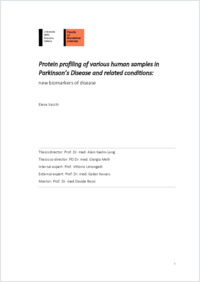Protein profiling of various human samples in Parkinson’s Disease and related conditions : new biomarkers of disease
- Vacchi, Elena
- Kaelin-Lang, Alain (Degree supervisor)
- 2022
PhD: Università della Svizzera italiana, 2022
Parkinson’s disease
Proteinopathies
Multiple system atrophy
Skin biopsy
Blood
Alpha-synuclein
Neurodegeneration
Extracellular vesicles
Biomarkers
Machine learning
English
Parkinson’s disease (PD) is the second most frequent neurodegenerative disorder of the elderly, characterized by selective dysfunction and progressive loss of dopaminergic neurons in the substantia nigra-pars compacta, associated with pathologically α-Synuclein (αSyn) deposits in the brain and peripheral organs. To date, PD remains without effective causal treatment and a definitive diagnostic test. Thus, the discovery of biomarkers is essential for better and more efficient treatment of the patients and the development of specific disease-modifying therapies. With the aim to identify a biomarker for PD and develop a not invasive and reliable diagnostic test, I investigate two peripheral tissues, skin and blood tissues, both easily accessible and of high interest for PD’s biomarkers research. Indeed, the skin contains peripheral autonomic nerves strongly involved at early stages of PD, while blood contains subpopulations of EVs produced by central nervous system cells carrying information about brain pathology and involved in immune and inflammatory pathways. A longitudinal case-control study was performed enrolling patients with PD (n=30), age-matched healthy control (n=22), and atypical parkinsonism (AP, n=23). In skin biopsy, multiple forms of pathological αSyn and intraepidermal nerve fiber density (IENFD) reduction were investigated, and the diagnostic accuracy was evaluated for each of them. Moreover, these parameters were measured longitudinally at baseline and after two years to assess their capability to predict disease progression. In blood, distinctive plasmatic extracellular vesicles (EVs) subpopulations were characterized by simultaneous immunophenotyping 37 different membrane proteins. The diagnostic accuracy of the most expressed was determined, and a diagnostic model based on EV surface markers expression was built via supervised machine learning algorithms. A higher expression of all the pathological αSyn forms and an overt small fiber neuropathy were found in PD skin compared to healthy subjects and patients with tauopathies. A progression of denervation, not of pathological αSyn, was seen in PD at two years-follow-up: lower IENFD at baseline was associated with a cognitive and motor decline in PD. Moreover, a skin biopsy-derived compound marker, resulting from a linear discrimination analysis model of all the parameters, stratified patients with accuracy (77.8%), including the discrimination between PD and other types of synucleinopathies (84.6%). In blood, a higher amount of EV was identified in PD. 17 out of 37 EV-surface markers were statistically differentially expressed between groups, most of which were related to inflammatory/immune response. A random forest diagnostic model based on these EV markers expression correctly classified 88.9% of patients with reliable diagnostic performance after internal and external validations. In conclusion, skin and blood analysis provided relevant results, potentially impacting clinical practice. Both are minimally invasive tests for patients and can be repeated over time to follow up the course of the disease. While for EV, the field is new and needs further investigation, for skin, the next step should be a multicentric standardization of the technique.
- Collections
- Language
-
- English
- Classification
- Medicine
- License
-
License undefined
- Open access status
- green
- Identifiers
-
- URN urn:nbn:ch:rero-006-120783
- ARK ark:/12658/srd1320918
- Persistent URL
- https://n2t.net/ark:/12658/srd1320918
Statistics
Document views: 270
File downloads:
- 2022BIOMED002: 399
